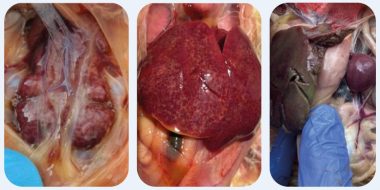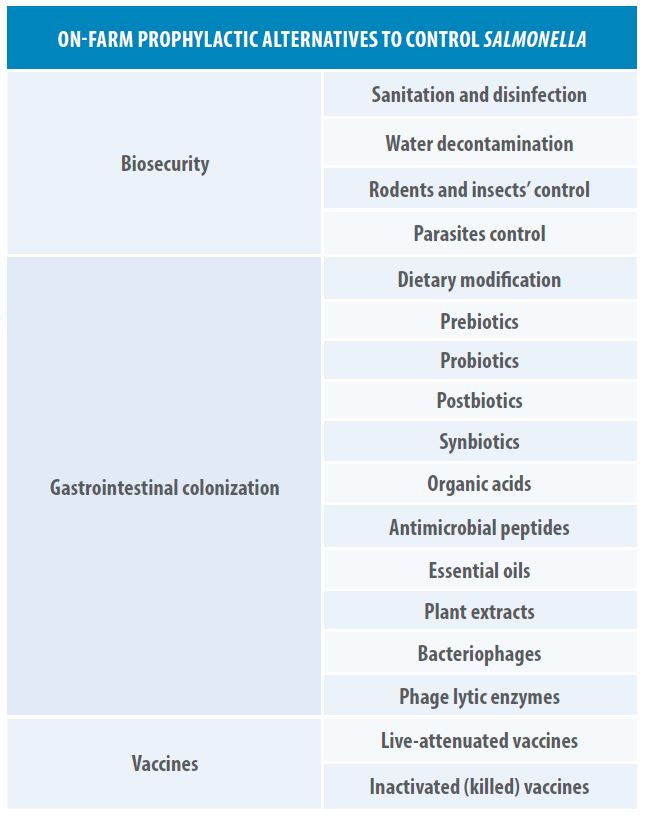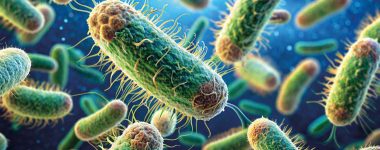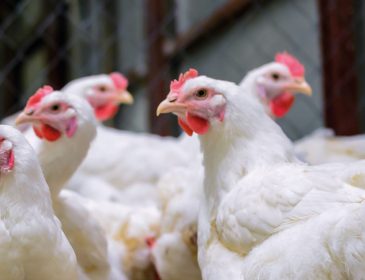
Fowl typhoid and pullorum sickness in birds are attributable to the host-adapted Salmonella serovar Gallinarum (SG) biovar Gallinarum and Pullorum, respectively, resulting in extreme mortality prices and substantial productiveness losses.
- Nonetheless, on account of its restricted host spectrum, Salmonella serovar Gallinarum would not characterize a public nicely being hazard.


Instead, the non-adapted Salmonella, along with serovars Enteritidis (SE) and Typhimurium (ST) are primarily essentially the most prevalent serovar-causing human salmonellosis outbreaks.
- Apparently, roughly 25% of human salmonellosis cases are derived from poultry meat and egg consumption.
- Subsequently, the worldwide monetary and public nicely being risks that Salmonella possesses, along with the need to reduce its prevalence inside the poultry enterprise, are evident.
Worldwide efforts to handle host-adapted and non-adapted Salmonella all by means of the poultry manufacturing chain are intensifying.
- Many pre-harvest (prophylactic and therapeutic) and post-harvest intervention methodologies have been developed to chop again Salmonellas’ affect on the poultry enterprise and public nicely being.
- Among the many many fully completely different on-farm prophylactic alternate choices to handle Salmonella in poultry (Desk 1), vaccination will likely be highlighted as a result of the chief method.
- Nonetheless, evaluation stays to be needed to boost the effectiveness of current industrial vaccines.
- The poultry enterprise and meals safety organizations urge researchers to develop novel Salmonella vaccine formulations capable of enhancing the protective outcomes achieved by current industrial vaccines and vaccination packages.
- To assist this intention, it is vital to know the strengths and limitations of for the time being accessible industrial vaccines.

Salmonella vaccine administration in poultry intends to decrease the Salmonella tons of inside the birds and ambiance, thereby stopping sickness, interrupting the transmission cycle inside and between flocks, supporting sustainable financial results in poultry manufacturing, and bettering meals safety.
- Since oral and respiratory mucosa are frequent an an infection routes for Salmonella, the following expertise of Salmonella vaccines ought to present environment friendly security notably in mucosal surfaces.
- Moreover, one of the best Salmonella vaccine ought to defend in direction of systemic an an infection, be irreversibly attenuated for individuals and animals, have extreme effectivity in decreasing fecal excretion and egg an an infection, be applicable with completely different Salmonella administration measures, and provide a cheap bacterial administration.
- For a vaccine to carry out its perform, it ought to efficiently work along with the hen’s innate and adaptive immune system and set off a robust, specific, multilayered, and long-lasting defending immune response with out inducing opposed outcomes on the nicely being or productive parameters of the flocks.
- For this intention, vaccines in direction of Salmonella in poultry have been developed largely using total bacterial cells, each live-attenuated or inactivated (killed).
- Though, makes an try have been made to provide subunit vaccines with outcomes exhibiting good mucosal, cellular and humoral immune responses, along with security in direction of SE and ST challenges.
- Furthermore, the revolutionary ghost vaccines have been demonstrated to be efficacious in producing humoral and cellular immune responses and eliminating systemic an an infection of SE and ST wild-type strains.

LIVE-ATTENUATED AND INACTIVATED (KILLED) SALMONELLA VACCINES
Inside the early 1800s, it was demonstrated that repeated bacterial passages could reduce their disease-causing potential by the use of cumulative mutations, just a few of which decrease the expression of genes involved in bacterial virulence.
Following this discovery, assorted approaches have been employed to create live-attenuated Salmonella strains. By mutating genes in wild parental strains related to host survival, metabolism, and virulence parts, these strains have been constructed as candidates for live-attenuated vaccines.
Alternatively, the inactivated Salmonella vaccines’ preliminary work was achieved by Dr. Smith in the middle of the mid-50s. From that point onward, the inactivation strategy of microbial cells has been achieved using formaldehyde, glutaraldehyde, acetone, and completely different chemical compounds equal to β-Propiolactone, along with bodily methods equal to heat.
- Recently, utilized sciences equal to electron beam or gamma radiation have been studied for bacterial inactivation.
- These new utilized sciences act quickly by damaging the double-strain and single-strain DNA contained in the bacterial cell.
- Thus, reverse to chemical inactivation, they defend the antigenic flooring protein integrity in the middle of the inactivation course of, allowing the initiation of an enhanced humoral and cellular immune response in vaccinated birds.
- As an example, Ji and colleagues (2021) found that SG inactivated with gamma radiation initiated a greater humoral immune response than a live-attenuated SG 9r vaccine and a greater cell-mediated immune response than a formalin-inactivated vaccine.
Regarding live-attenuated bacterial vaccine strain constructing, novel molecular biology methods enable researchers to larger understand the virulence parts involved in Salmonella an an infection on the gene stage and to selectively inactivate, delete and transpose virulence genes.
Then, enabling the design and constructing of site-specific and scarless genetically modified live-attenuated Salmonella strains applicable for vaccine development on account of their antigenicity, immunogenicity and safety. In addition to, Salmonella live-attenuated strain constructions can perform a platform to specific immunogenic protein epitopes for the design of heterologous recombinant sub-unit vaccines.
As beforehand talked about, Salmonella vaccines, each live-attenuated or inactivated, ought to ensure applicable activation of every innate and adaptive arms of the birds’ immune system to provide defending and long-lasting immunity.
- Keep-attenuated Salmonella vaccines have been confirmed to efficiently induce every cellular and humoral immune responses.
- Nonetheless, the traits and extent of these responses depend on considerations such as a result of the constructed strain, administration route and utilizing immunostimulants.
- Administering attenuated Salmonella strains by the use of the oral route permits the pathogen-host interaction to happen in a pure path. It mimics a fundamental an an infection which has been well-known as an advantageous attribute of keep attenuated vaccines.
- Nonetheless, live-attenuated Salmonella vaccines may be parenterally administered, exhibiting good humoral and cell-mediated responses.
- Nonetheless, from a particular perspective, live-attenuated Salmonella strains keep capable of reverting their virulence and pathogenicity, although researchers have been attempting to ensure irreversible attenuation by fully completely different means with variable outcomes.
- Due to the inherent risks of using attenuated Salmonella vaccines, the poultry enterprise has been using inactivated (killed) Salmonella vaccines, and researchers are engaged on rising newer inactivated vaccines as safer alternate choices to attenuated-live vaccines.
Reverse to attenuated keep vaccine strains, inactivated Salmonella vaccine strains lack the potential to set off an an an infection that initiates a robust immune response.
Subsequently, inactivated vaccines must be administered parenterally and along with an adjuvant confirmed to efficiently provoke and keep a sufficiently sturdy activation of the innate and adaptive immune packages.
As a result of the perform of adjuvants in inactivated vaccines is crucial to conducting the vaccination objective, it stays an energetic house of research.
- The immunological outcomes of using the parenteral route for vaccination with inactivated Salmonella vaccines are significantly fully completely different from these triggered by an orally administered live-attenuated vaccine capable of mimicking the Salmonella an an infection course of.
- Although inactivated vaccines have been confirmed to set off a potent humoral systemic immune response, it has been demonstrated that these do not strongly stimulate IgA manufacturing.
- Thus, these vaccines fail to protect the mucosal lumen and epitheliums from Salmonella colonization.
- Likewise, memory cell-mediated immune responses is not going to be stimulated by inactivated Salmonella vaccine administration, which reduces their effectiveness.
- Then, although not however commercially accessible, new adjuvants allowing inactivated Salmonella vaccines to be orally delivered are being developed.
- As an example, chitosan nanoparticles used as an adjuvant for oral provide of inactivated Salmonella vaccine in broilers have been confirmed to set off defending antigen-specific humoral systemic and mucosal immune responses, thus decreasing the Salmonella tons of after drawback.
- In addition to, an revolutionary know-how is being examined to spice up the potential of parenteral-administered inactivated Salmonella vaccines to elicit humoral and cellular defending immune responses.
- On this regard, an experimental inactivated Salmonella vaccine design based mostly totally on utilizing agonistic-CD40 DNA aptamers successfully stimulated the manufacturing and launch of IgA into the gastrointestinal tract of broiler chickens, very important T- (CD4+ and CD8+) and B-cell responses after improve vaccination, and significantly diminished the cecal Salmonella tons of in chickens following an issue with SE (Uribe-Diaz et al., unpublished; Omolewu et al., unpublished).

SUMMARY AND CONCLUSIONS
- Controlling host-adapted and non-adapted Salmonella serovars in poultry stays a vital public nicely being and monetary priority.
- Standard vaccine approaches, equal to live-attenuated and inactivated vaccines, have carried out a central perform in mitigating these risks.
- Keep-attenuated vaccines can induce sturdy, broad immunity by mimicking pure an an infection pathways nevertheless carry risks of reversion to virulence.
- Fairly the alternative, inactivated vaccines, whereas safer, primarily elicit humoral responses and sometimes lack the sturdy mucosal and cellular immunity needed to efficiently administration Salmonella colonization inside the gut.
Newest advances in molecular biology and immunology are transforming vaccine development for Salmonella administration. These utilized sciences enable the design of genetically regular, attenuated Salmonella strains which could be extraordinarily immunogenic and with a minimized hazard of virulence reversion, presenting a promising technique for safer live-attenuated vaccine constructs.
Concurrently, enhancements in adjuvants and provide packages—equal to nanoparticles and agonistic-CD40 DNA aptamers— can enhance the efficacy of inactivated vaccines. These developments can improve mucosal immunity and cellular responses, making inactivated vaccines less complicated at stopping Salmonella colonization and shedding.
In rising additional setting pleasant vaccines and environment friendly vaccination packages, understanding the immune responses triggered by Salmonella vaccines is crucial.
- Evaluation into the vaccine’s mechanisms to stimulate every mucosal and systemic immunity is vital for optimizing defending outcomes.
- Combining keep and inactivated vaccines, guided by this understanding, affords synergistic security, exploiting the broad immune responses to remain vaccines alongside the centered, safe immunity of inactivated vaccines.
Collectively, these novel approaches ship the poultry enterprise nearer to rising next-generation Salmonella vaccines and tailor-made vaccination packages that enhance safety and immunogenicity.
Continued evaluation and optimization on this house may yield strategies that not solely defend poultry nicely being and productiveness however as well as reduce the prospect of Salmonella transmission to individuals, supporting public nicely being and meals safety initiatives globally.
Provide: Avinews.com
